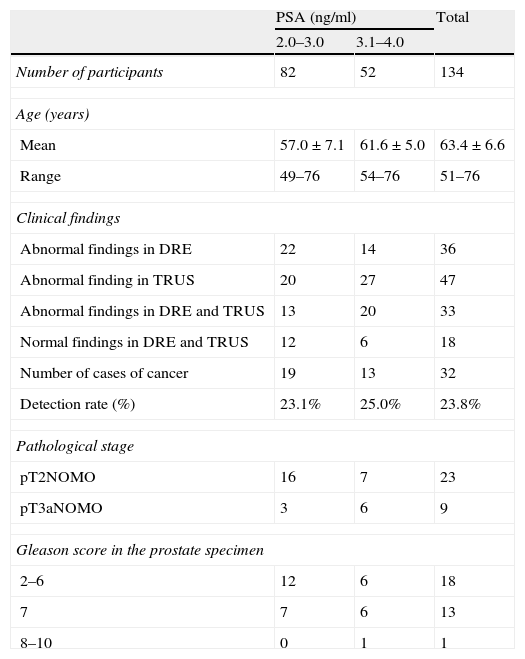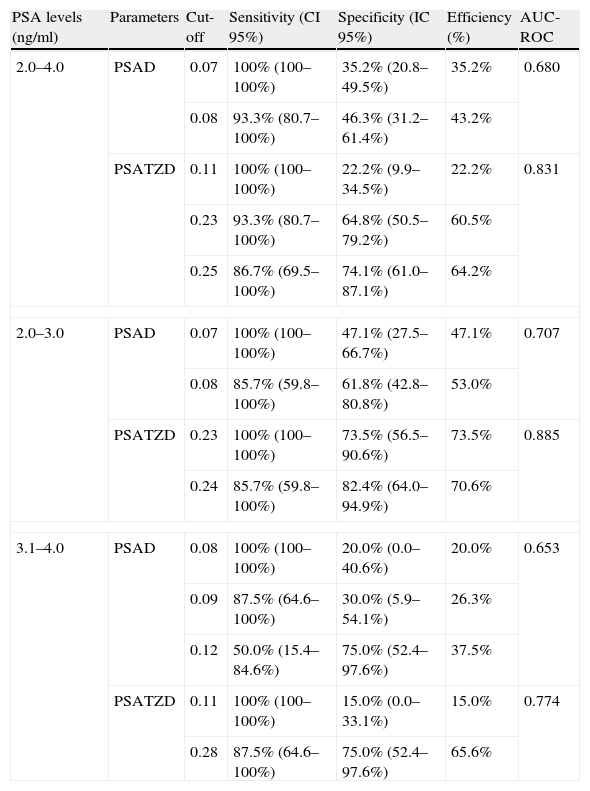To assess the diagnostic significance of prostate-specific antigen (PSA), density (PSAD) accuracy, and PSAD adjusted by transition zone volume (PSATZD) in men with PSA levels between 2.0 and 4.0ng/ml.
MethodsBetween 2000 and 2010, 138 men with PSA levels between 2 and 4.0ng/ml underwent transrectal ultrasonography (TRUS) and 12-core prostate biopsy. Diagnostic accuracies for various cut-offs of PSAD and PSATZD were investigated according to subdivided PSA levels of 2.0–3.0ng/ml and 3.1–4.0ng/ml.
ResultsThe detection rate of prostate cancer was 23, 8% (32/134). The percentage of patients with extracapsular disease was 28.1% (10/32) and primary Gleason grade 4 or 5 was obtained in 8/32 cases (25%) patients. The transition zone volume and PSATZD in cancer cases were significantly different in comparison with those in non-cancer cases. The area under the receiver operating characteristic curve for PSATZD was significantly higher in comparison with that for PSAD in the same subdivided PSA ranges. The diagnostic efficiency for PSATZD was higher than that for PSAD. The diagnostic efficiency showed the highest value at the cut-off level for PSATZD of 0.23 and 0.28 in men with PSA levels of 2.0–3.0ng/ml and 3.1–4.0ng/ml, respectively.
ConclusionsThe use of PSATZD cut-offs as a biopsy indication may reduce many unnecessary biopsies without missing most prostate cancer cases in the PSA range of 2.0–4.0ng/ml.
Evaluar la significancia diagnóstica del PSA, de su densidad (PSAD) y de la PSAD ajustada por el volumen de la zona de transición (PSATZD) en hombres con niveles de PSA entre 2,0 y 4,0 ng/ml.
MétodosEntre el 2000 y el 2010, 138 hombres con niveles de PSA entre 2,0 y 4,0 ng/ml fueron sometidos a ultrasonografía transrectal (TRUS) y biopsia prostática de 12 fragmentos. Se investigó la precisión diagnóstica de varios puntos de corte de la PSAD y de la PSATZD en rangos de PSA de 2,0 a 3,0 ng/ml y de 3,1 a 4,0 ng/ml.
ResultadosLa tasa de detección del cáncer de próstata fue de 23,9% (32/134). El porcentaje de pacientes con enfermedad extracapsular fue de 28,1% (10/32) y se obtuvo primarios de grado Gleason 4 o 5 en 8 de 32 casos (25%). El volumen de la zona de transición y la PSATZD en los casos de cáncer fueron significativamente diferentes en comparación con los obtenidos en los casos sin cáncer. El área bajo la curva de la característica operativa del receptor (ROC) de la PSATZD fue significativamente mayor que la de la PSAD en los mismos rangos de subdivisión del PSA. La eficiencia diagnóstica de la PSATZD fue mayor que la de la PSAD. La eficiencia diagnóstica fue mayor en los niveles de corte de PSATZD de 0,23 y 0,28 en hombres con valores de PSA de 2,0 a 3,0 ng/ml y de 3,1 a 4,0 ng/ml respectivamente.
ConclusionesEl uso de puntos de corte de la PSATZD como indicación para biopsias evitaría muchas biopsias innecesarias sin pasar por alto la mayor parte de cánceres de próstata en el rango de PSA de 2,0 a 4,0 ng/ml.








